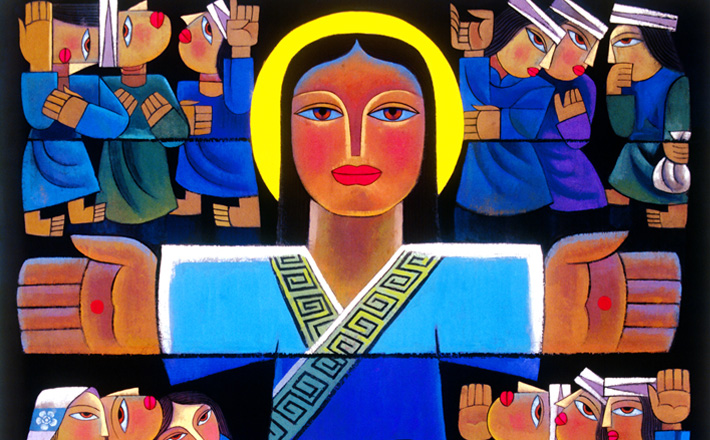Commentary on John 20:19-31
John’s second report of Jesus’ resurrection appearance serves as the Gospel reading for the Second Sunday of Easter in Year A, B, and C.
Most scholars believe this chapter concludes the Johannine story, with John 21:1-25 being a later addition.
One might look at this entire chapter as recounting just how sturdy the tomb is in our creaturely thinking. Although the church may thunder with the Easter response, “He is Risen indeed!” actual congregational experience with contemporary tombs may seem more stubborn.
Examples are legion: opioid addiction, chronic disease, or irrational but paralyzing fear, among others — these seem all too common in our time and all too easily exploited, but not so easily relieved.
Alternatively, the unfairly titled “Doubting” Thomas underscores a deep yearning for God’s presence in our world. Like Thomas, many in our “secular age” want “data” or indications of Christ’s presence in the world as we know it, with its pierced hands and side. Absent such data, faith in the triumph of light over darkness seems implausible or at least out of reach.
Either or both of these trajectories may provide the pastoral concern as we read this text. Positively, this chapter chronicles “little” resurrections in the wake of Jesus, the Resurrected One.
Resurrection is too magnificent to grasp or, if we do grasp the One in whom there is no darkness, our knowledge is fleeting. Indeed, apart from the Beloved Disciple (John 20:8), it seems as if the disciples were locked into familiar tombs: upon seeing the empty tomb, the disciples didn’t preach, they didn’t join the choir, they went home (John 20:10).
Mary Magdalene stands outside the empty tomb, weeping, seeing only strangers indifferent to her dilemma (John 20:11-15).
Then, later, the disciples (perhaps the ones who went home in vs. 10), lock themselves into a house for fear of persecution; and not least, Thomas insists he will not believe “until [he sees]” the marks of crucifixion in Jesus’ body.
If we ever believed that resurrection would be a snap, these texts suggest a more nuanced account of what it is like for us to leave our own tombs, some of them self-made and to that extent seemingly impregnable. At the same time, each of these accounts suggests that the Jesus we would “see” on our own is vastly inferior to the Jesus who reveals himself as the Resurrected One.
“Fear,” says German Chancellor Angela Merkel, “has never been a good advisor.” Growing up in the former DDR (East Germany), she knows a thing or two about fear, its seductive and destructive powers. Likewise, John’s narrator speaks of the “fear of the Jews” which demands critical interpretation. According to Gail R. O’Day, the Johannine community understands itself to be a persecuted religious minority and “the Jews” is shorthand for that bitter intra-Jewish struggle.1
Additionally, we should not lose sight of the irony of a Jewish Jesus, the Resurrected One, appearing amid those who are in hiding “for fear of the Jews” (19b). Against docetic tendencies, Jesus exhibits his humanness (the wounds in his hands and side), which is never without ethnic complexion even if it is not defined by it.
Contemporary analogies anyone? Talk about “building walls” here and abroad, the scapegoating of ethnic and religious groups, has become too familiar in American political discourse. Much of it is based on fear, an emotion that leads us to believe that we are in possession of “perfect” understanding. We do well to remember the words of another John: “There is no fear in love, but perfect love casts out fear” (1 John 4:18a).
In this case, the interpretive obligation is unapologetically public and, yes, political. But in the spirit of John’s gospel, the interpretive practice is incarnational, naming how this text forces us to subject the rhetoric of fear to the counter-testimony of the “stranger” in our midst. Think for example of the peaceful witness of Rose Hamid, the Muslim woman ejected from a Trump rally; 2 or perhaps the image of a uniformed police officer in Washington D.C. “breaking up” a group of teenagers not with coercion but with dance.3
Not insignificantly, Jesus’ appearance in this context of fear culminates with one of the distinctive marks of the Christian community, the practice of forgiveness (John 20:23). As a practice, forgiveness entails doubting our own fear-based conclusions. Forgiveness calls us to trust in God’s power to initiate resurrection in our midst, precisely where we least expected it.
On to Thomas. A pair of scientists declares “even the most logically beautiful theories or thought experiments can’t hold a candle to real-world data.” This sentiment seems to speak to the yearning of Thomas: “Until I see the mark of the nails in his hands, and put my hand in his side, I will not believe” (John 20:25b).
Apparently, Thomas believes in data-driven conclusions. And, truth be told, so do we. Thomas speaks to our values more than we recognize. As people of faith, we experience an almost reflexive dislike for “doubting” Thomas, but this is neither fair to him nor to the biblical witness.
True, the biblical text does not engage in abstract arguments about the “existence” of God as a philosophical concept. Nevertheless, the modern debate around the existence of God boils down to this question, one that is not uniquely modern, according to Patrick D. Miller: “Is God a reality, one with which we have to deal, or not? Is God real?” Miller believes the psalmist is preoccupied with this central concern: is God present in our suffering? does God exist in the midst of pain, injustice, and doubt? Miller underlines the characteristic way the Psalms juxtapose extravagant faith claims alongside deep doubts.4
Perhaps in Thomas we hear the one who prays like the psalmist prays, pleading for God’s existence amid our groans, watching for God in the land parched with doubt but no water, looking for the God who bears the marks of our weary world in his own body.
Perhaps we could hear Thomas this way, as one who seeks evidence of God’s presence in the world, through the “mark of the nails in his hands” … if so, Thomas’ response to Jesus suggests vastly more than evidence for God’s existence, more even than the Lord God alone, which would have been enough. But, no, on Thomas’ lips we hear the personal confession, “My Lord and my God!” (28b).
Thomas wanted only to see the nail marks in Jesus’ hands, to put his hand into his side — but what he received on his lips and within his heart was vastly more than the wounds. He received his Lord and God.
Notes:
1 Gail R. O’Day, “The Gospel of John” in New Interpreter’s Bible, vol. 9 (Nashville: Abingdon Press, 1995), 505. See also “Reflections” 647-651.
2 Jeremy Diamond, “Silently Protesting Muslim Woman Ejected from Trump Rally” in CNN (11 January 2016), accessed on 22 January 2016 at http://www.cnn.com/2016/01/08/politics/donald-trump-muslim-woman-protesting-ejected/index.html
3 Perry Stein, “A D.C. Cop Tried to Break Up a Group of Teens” in The Washington Post (28 October 2015) accessed on 22 January 2016 at https://www.washingtonpost.com/news/local/wp/2015/10/28/a-d-c-cop-tried-to-break-up-a-group-of-teens-it-ended-in-this-impressive-dance-off/.
4 Patrick D. Miler, The Lord of the Psalms (Louisville: Westminster John Knox Press, 2013), 1-2.


April 3, 2016